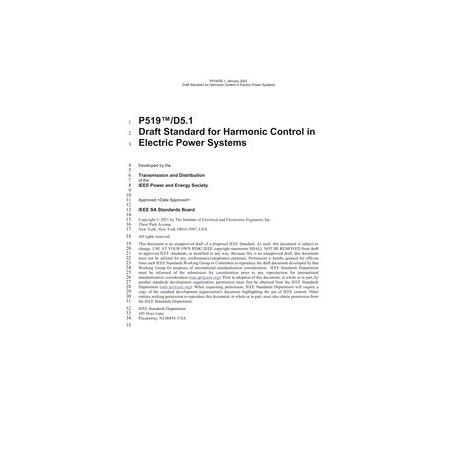Cart
0
Product
Products
(empty)
No products
To be determined
Shipping
$0.00
Total
Product successfully added to your shopping cart
Quantity
Total
There are 0 items in your cart.
There is 1 item in your cart.
Total products
Total shipping
To be determined
Total
New
 View larger
View larger
 View larger
View larger
IEEE P519
M00007866
New product
IEEE P519 IEEE Draft Standard for Harmonic Control in Electric Power Systems
standard by IEEE,
Full Description
Scope
This standard establishes goals for the design of electrical systems that include both linear and nonlinear loads. The voltage and current waveforms that may exist throughout the system are summarized and waveform distortion goals for the system designer are established. The interface between sources and loads is described as the point of common coupling; and observance of the design goals will minimize interference between electrical equipment. The limits in this standard represent a shared responsibility for harmonic control between system owners or operators and users. Users produce harmonic currents that flow through the system owner's or operator's system which lead to voltage harmonics in the voltages supplied to other users. The amount of harmonic voltage distortion supplied to other users is a function of the aggregate effects of the harmonic current producing loads of all users and the impedance characteristics of the supply system. Harmonic voltage distortion limits are provided to reduce the potential negative effects on user and system equipment. This standard addresses steady-state limitations.Purpose
This document sets the quality of power related to harmonics that is to be provided at the point of common coupling, and is not intended for application to individual pieces of electrical equipment.Abstract
Revision Standard - Superseded - Draft.Goals for the design of electrical systems that include both linear and nonlinear loads are established in this standard. The voltage and current waveforms that may exist throughout the system are described, and waveform distortion goals for the system designer are established. The interface between sources and loads is described as the point of common coupling and observance of the design goals will reduce interference between electrical equipment. This standard addresses steady-state limitations. Transient conditions exceeding these limitations may be encountered. This document sets the quality of power that is to be provided at the point of common coupling. This document does not cover the effects of radio-frequency interference; however, guidance is offered for wired telephone systemsIn stock

